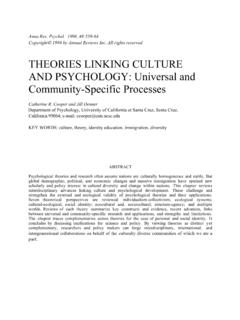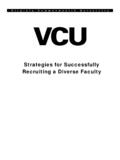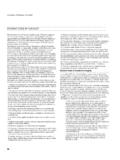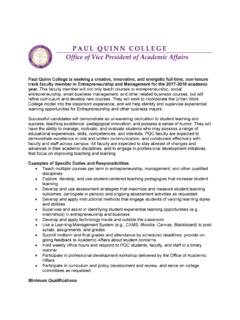Transcription of What is a College Culture? Karen A. McClafferty …
1 What is a College Culture? Facilitating College Preparation through Organizational ChangeKaren A. McClaffertyPatricia M. McDonoughAnne-Marie Nu ezUniversity of California, Los AngelesGraduate School of Education & Information StudiesThis paper may be downloaded at: presented at the annual conference of the American Educational Research Association,New Orleans, LA, April 1-5, 2002. Please do not quote or cite without the authors more information please contact: is a College Culture? Facilitating College Preparation through Organizational ChangeINTRODUCTIONIn families without College knowledge and resources, schools are often the only availableresource for providing basic information on why College is important, advising on appropriateclasses, and being sounding boards for College choices. Given counselors heavy caseloads andmyriad responsibilities, however, it is clear that one solitary professional can not carry a school scollege resource infrastructure (Lombana, 1985; McDonough and Perez, 1998; Monson andBrown, 1985).
2 Changes must occur throughout schools so that the College mission is heard loudand clear by all students . Moreover, these expectations must be present from the earliest stagesof an academic career and must be communicated at every opportunity. This is bestaccomplished through a school culture that encourages all students to consider College as anoption after high school and prepares all students to make informed decisions about availablepost-secondary options something we have termed a College culture . The primary focus of this paper is a template for creating a school environment wherecollege is a reasonable expectation for all students . Drawing from the research literature andlessons learned from more than four years of partnership work between a public researchuniversity and a cluster of urban, K-12 schools, we outline a set of conditions that are consistentwith the creation of a College culture . We offer examples from our own work about how theseconditions might play out at the middle school and high school levels and situate them within therelevant literature on College access.
3 The paper concludes with some reflections on the process ofcultural PROBLEM OF College ACCESSFor many students , early College plans are the most essential factor in determiningwhether or not they will pursue and/or complete a College degree (Alexander and Cook, 1979).But College plans do not simply emerge on their own. Rather, they must be fostered andencouraged at home, at school, or both. This does not happen in the same way or to the samedegree for all students , and not surprisingly, the most stubborn barriers to parity in entrance tocollege are in social class background (McDonough, 1997). Often, social class background ismeasured in terms of parental educational levels, which are strongly associated with studenteducational achievement. In 1999, for instance, the majority of students (82%) whose parentshad at least a bachelor s degree went on to College immediately after high school about half (54%) of those whose parents had not gone beyond high school, and slightlymore than a third (36%) of those whose parents had not completed high school, enrolledimmediately (NCES, 2001).
4 More often than not, students who are at a disadvantage because oftheir social class background are also students of color (NCES, 2001).Despite a generation of concerted policy and programmatic efforts and despite thesubstantial gains in educational attainment over the past fifty years, African Americans andLatinos remain decidedly underrepresented on the nation's campuses (Horn & Chen, 1998;Nettles, 1991). Most often, Black and Latino students have high career and academicexpectations, but the lack of relevant high school programs and school structures tends to doomthem to a cycle of failure (Solorzano, 1992a, 1992b). Indeed, the literature shows that a school sculture has a strong impact on students aspirations and achievement (Falsey and Heyns, 1984;Alexander and Eckland, 1977). An important aspect of a school s culture is thecomprehensiveness of the school counseling , the responsibility for providing students with the necessary information andresources to prepare for College has fallen to College counselors housed within individual highschools.
5 This does not mean, however, that the responsibility is being adequately met. Schoolcounselors are grossly overworked: A decade ago in four of the ten largest cities, theaverage high school counselor-to-student ratio was 1:740 (Fitzsimmons, 1991). These numbershave not improved in recent years and some states, notably California, where the counselor-to-student ratio is 1:979, offer even less advisement than those largest inner city schools. At its best,the current national average of one guidance counselor to 561 students does not allow for muchpersonal attention (California Association of School Counselors, 2001).Furthermore, over the past three decades, the professional responsibilities of counselorshave multiplied and changed. A review of three decades of counseling research, surveys, andprofessional journals reveals that the relationship between College advising and other counselingtasks has consistently been problematic.
6 The big three tasks of high school counseling today arescheduling, discipline, and monitoring dropout potential (Lombana, 1985; McDonough & Perez,2000; Monson & Brown, 1985). As part of a larger phenomenon of turning to schools to handlesocial ills, today's school counselor can also be expected to focus substantial effort on dropout,drug, pregnancy, and suicide prevention, as well as sexuality and personal crisis these needs have been met, public high school counselors may have only limitedtime for College choice advising. In fact, because of economic hardship, many public highschools have effectively divested themselves of College advisement, with counselors spending aslittle as 20 percent of their time on College guidance (Chapman and De Masi, 1985). Moreover,to whatever extent College counseling is available in America's high schools, it appears as thoughstudents find it less than overwhelmingly useful.
7 According to one survey of undergraduates'4college decisionmaking processes, 60 percent of 1993 freshman said that the advice of their highschool counselor was not very important to them (Astin, et al. 1993).Clearly, if all students are to receive the guidance and preparation that will allow them tomake well-informed decisions about how to effectively prepare for and choose a College , wemust bring about changes not only in the structure of counseling but also in the cultures of ourschools. Past research indicates that students desperately need basic information about collegeoptions, particularly for more selective colleges. Moreover, they need to receive it early enoughin their educational careers for them to enroll in appropriate classes and make other necessarydecisions. Specifically, students express the need for information about College types, eligibilityrequirements, and the subtleties of competitive eligibility.
8 Often, underrepresented students (typically African-American and Latino students ) know the most about community colleges andare most frequently advised by teachers and siblings to attend them to remediate, improvegrades, and save money (McDonough, 1999). Secondary and even primary schools have animportant and irreplaceable role to play in guiding each student s decision about whether or not afour-year College is an CREATING A College culture PROJECTP roject StructureIn 1997, UCLA, together with the non-profit, public interest organization The AchievementCouncil, formed a partnership with a cluster of 24 local schools (two high schools, four middleschools, and 18 elementary schools). The partnership emerged from a concern that the numbersof students going to highly selective colleges from the district and this ethnically and raciallydiverse cluster in particular have been declining steadily in the last decade.
9 Unfortunately, both5high schools in the cluster have high drop-out rates and generally low participation by both low-income students and students of color in honors and advanced placement courses. Throughoutthe cluster, College -going rates are far from equitable across ethnic groups and Creating a College culture project emerged from this partnership with the broad goal ofensuring that the schools involved devote energy, time, and resources toward College preparationso that all students are prepared for a full range of postsecondary options upon graduation. A keycomponent of the project at the middle school and high school levels has been the support of anew or additional counseling position. Funded by the school district, this aspect of the projectallowed each of the schools to bring in a person who assumed responsibility for initiating andcarrying out activities that contribute to the College culture .
10 These individuals were first hired forthe 1999-2000 academic year. All of the middle schools created a new position (a collegecoach ), and the two high schools each hired an additional counselor, decreasing the caseload ofthe entire counseling staff and creating opportunities to allow all counselors to become One presents demographic data for the four middle schools and two high schoolsthat are participating in the partnership work. It is these six schools that comprise the heart of theCreating a College culture One: Demographic Description of School Sites (1999-2000 Academic Year)MiddleSchool 1 MiddleSchool 2 MiddleSchool 3 MiddleSchool 4 HighSchool 1 HighSchool 2 Total Students101710601522118727032060% English-language Learners25%28%4%31%22%3%% Reduced/Free Lunch82%74%31%77%22%9%Ethnic Breakdown Asian African American Latino White Other3%22%65%7%3%2%19%71%7%1%3%61%19%16% 1%2%36%57%4%1%8%10%65%15%2%2%70%15%12%1% Why a Cultural Approach?






